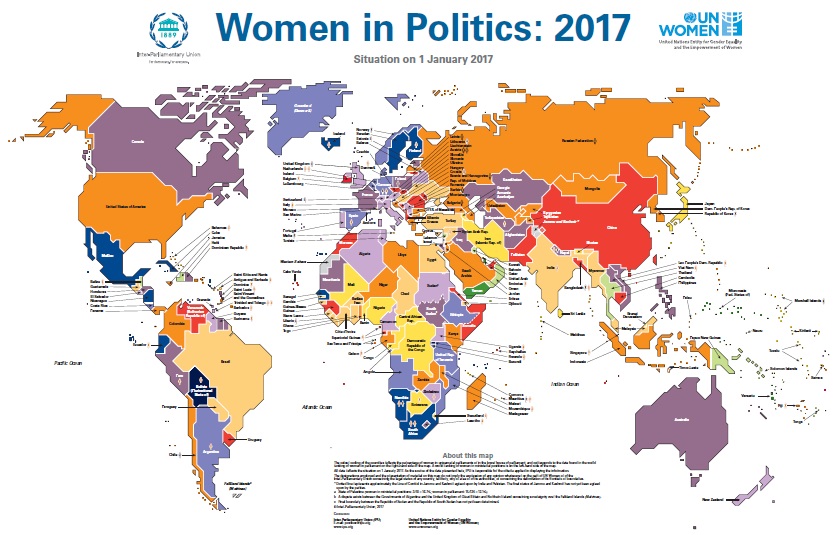The inequality in gender representation in Parliament has no linear correlation with the general quality of democracy in a country. For example, the representation of women in Indonesian parliament is currently below 20 percent, but the quality of democracy in Indonesia is relatively better than many other countries with high women parliamentary representation.
We need to be aware of the importance of women representation to the quality of democracy in a country. According to a comparative analysis on the global democracy rank and the rate of women representation in parliament, we can see that most countries with high-quality democracy are usually the country with better gender representation in parliament. Vice versa, most undemocratic countries are usually having low representation of women in parliament.
Let’s compare the 2017 data on women representation in parliament from Inter-Parliamentary Union with the democracy index from Freedom House:
|
Women Representation Ranking |
Democracy Ranking |
Country |
Women Representation |
Democracy Index (sclae 0 – 100) |
|
1 |
164 |
Rwanda |
61.3 |
24 |
|
2 |
91 |
Bolivia |
53.1 |
68 |
|
3 |
177 |
Cuba |
48.9 |
15 |
|
4 |
12 |
Iceland |
47.6 |
97 |
|
5 |
129 |
Nicaragua |
45.7 |
47 |
|
6 |
3 |
Sweden |
43.6 |
100 |
|
7 |
73 |
Senegal |
42.7 |
78 |
|
8 |
95 |
Mexico |
42.6 |
65 |
|
9 |
1 |
Finland |
42 |
100 |
|
10 |
74 |
South Africa |
42 |
78 |
|
99 |
94 |
Indonesia |
19.8 |
65 |
From the top ten list of countries with highest women representation in parliament, there are three countries with bad democracy index, they are Rwanda, Cuba, and Nicaragua. These countries are ranked as first, third, and fifth, respectively, in women representation ranking, but their democracy index are below 50 (24 for Rwanda, 15 for Cuba, and 47 for Nicaragua).
The rest of the countries on the list have democracy index more than 60. Bolivia, which has 53.1 percent of women representation in parliament, has 68 democracy index. Finland and Sweden have scored 100 in democracy index, and their women representation rate is 42 percent and 43.6 percent respectively. Meanwhile, Iceland has women represent rate at 47.6 percent with 97 of democracy index; Senegal 42.7 percent to 78; Mexico 42.6 percent to 65; and South Africa 42 percent to 78.
Indonesia is ranked at number 99 in women representation, and ranked at 94 in democracy index. The percentage of women in Indonesian parliament is 19.8 percent, while the score for the democracy index is 65.
Now let’s see how are the top 20 democratic countries doing regarding their women representation in parliament:
|
Democracy Ranking |
Country |
Score |
Percentage of Women in Parliament |
|
1 |
Finland |
93.4 |
42 |
|
2 |
Norway |
92.6 |
39.6 |
|
3 |
Sweden |
91.1 |
43.6 |
|
4 |
Denmark |
88.1 |
37.4 |
|
5 |
New Zealand |
87.8 |
34.2 |
|
6 |
Belgium |
87.6 |
38 |
|
7 |
Netherlands |
87.3 |
38 |
|
8 |
Ireland |
86.9 |
22.2 |
|
9 |
Canada |
85.7 |
26.3 |
|
10 |
Australia |
85.6 |
28.7 |
|
11 |
Switzerland |
85.5 |
32.5 |
|
12 |
France |
85.2 |
25.8 |
|
13 |
Germany |
85.1 |
37 |
|
14 |
United Kingdom |
85.0 |
30 |
|
15 |
Slovenia |
84.2 |
36.7 |
|
16 |
Austria |
83.2 |
30.6 |
|
17 |
Estonia |
82.9 |
26.7 |
|
18 |
Spain |
82.9 |
39.1 |
|
19 |
Portugal |
82.5 |
34.8 |
|
20 |
United States |
82.2 |
19.1 |
|
69 |
Indonesia |
62.3 |
19.8 |
According to the list of the top 20 democratic countries, it is only the United States that has less than 20 percent of women representation in parliament. The percentage is almost similar with the percentage of women representation in Indonesia, which is 19.8 percent. However, Indonesia is far below the US in regards with democracy ranking (69) with score of 62.3.
Therefore, we can safely say that 19 out of 20 top democratic countries have no problem with women representation. 99 percent of the countries have more than 25 percent of women representation, and 70 percent of them have more than 30 percent of women representation.
Based on the comparison of both data, we can draw two conclusions: (1) high percentage of women representation in parliament does not correlate with the quality of democracy in the country; (2) countries with high quality democracy usually have proper rate of women representation in parliament (at least 30 percent).
These conclusions will become more apparent if we compare the data in countries with the worst democracy index:
|
Ranking on Women Representation |
Country |
Percentage of Women Representation in Parliament |
Democracy Index |
|
190 |
Yemen |
0 |
14 |
|
189 |
Vanuatu |
0 |
80 |
|
188 |
Qatar |
0 |
26 |
|
187 |
Micronesia |
0 |
93 |
|
186 |
Oman |
1.2 |
25 |
|
185 |
Solomon Islands |
2 |
71 |
|
184 |
Haiti |
2.6 |
39 |
|
183 |
Papua New Guinea |
2.7 |
64 |
|
182 |
Lebanon |
3.1 |
44 |
|
181 |
Kuwait |
3.1 |
36 |
|
180 |
Belize |
3.1 |
87 |
|
179 |
Tonga |
3.8 |
74 |
|
178 |
Thailand |
4.9 |
32 |
Based on the comparison, in all 13 countries with lowest women representation in parliament, they also have poor democracy index. There are 53 percent of countries with democracy index below 45, they are Yemen, Qatar, Oman, Haiti, Lebanon, Kuwait, and Thailand.
Election System
If we compare the data on women representation with the election system implemented in a country, we can see that the type of election system implemented has a correlation with women representation.
|
Ranking on Women Representation |
Country |
Percentage of Women Representation in Parliament |
Type of Election System |
|
1 |
Rwanda |
61.3 |
Party List PR: ++ |
|
2 |
Bolivia |
53.1 |
MMP (Majority with party list PR: closed list) |
|
3 |
Cuba |
48.9 |
Endorsement of selected candidates |
|
4 |
Iceland |
47.6 |
Party List PR: Closed List |
|
5 |
Nicaragua |
45.7 |
Party List PR: Closed List |
|
6 |
Sweden |
43.6 |
Party List PR: Open List |
|
7 |
Senegal |
42.7 |
Parallel |
|
8 |
Mexico |
42.6 |
Parallel |
|
9 |
Finland |
42 |
Party List PR: Open List |
|
10 |
South Africa |
42 |
Party List PR: Closed List |
|
11 |
Ecuador |
41.6 |
Party List PR: Closed List |
|
12 |
Namibia |
41.3 |
Party List PR: Closed List |
|
13 |
Mozambique |
39.6 |
Party List PR: Closed List |
|
14 |
Norway |
39.6 |
Party List PR: Open List |
|
15 |
Spain |
39.1 |
Party List PR: Closed List |
|
16 |
Argentina |
38.9 |
Party List PR: Closed List |
|
17 |
Ethiopia |
38.8 |
FPTP |
|
18 |
Timor-Leste |
38.5 |
Parallel |
|
19 |
Angola |
38.2 |
Party List PR: Closed List |
|
20 |
Belgium |
38 |
Party List PR: Flexible List |
|
99 |
Indonesia |
19.8 |
Party List PR: Open List |
Based on the table above, we can see that countries that implement proportional representation (PR) system have higher degree of women representation compared to countries that implement plurality system (first past the post/FPTP). Out of the top 20 countries with highest women representation, only one country, Ethiopia, implement plurality system while also manage to have relatively high women representation rate (38.8 percent).
Meanwhile, the rest of the 19 countries implement PR system, either pure or mixed. Pure PR system has two distinct models: closd list and open list. Meanwhile, the mixed PR system may be implemented as a parallel or mixed-member proportional (MMP) type.
After comparing all of the data, we can draw a final conclusion that the rate of women representation in parliament does not affected by the quality of democracy in a country, but more by the type of election system implemented. Therefore, the rate of women representation in parliament may not be the indicator of democracy quality in a country, but it definitely shows what type of election system is more gender-friendly.[]
USEP HASAN SADIKIN
 Rumah Pemilu Indonesia Election Portal
Rumah Pemilu Indonesia Election Portal




